Spatiotemporal Distribution and Regional Imbalance of China’s Digital Economy
Abstract
1. Introduction
2. Review of the Literature
3. Research Methods, Index System and Data Sources
3.1. Research Methods
3.1.1. Entropy Weight Method
- (1)
- Standardization of data
- (2)
- Determine the indicators’ weights
- (3)
- Determine each sample’s overall score. The comprehensive score is computed using the following formula:
3.1.2. Three-Dimensional Kernel Density Estimation
3.1.3. Dagum Gini Coefficient and Decomposition
3.1.4. Spatial Autocorrelation
3.1.5. Local G Index
3.2. Variable Selection and Data Sources
3.2.1. Indicator System Construction
3.2.2. Data Sources
4. Characteristics of the Spatiotemporal Evolution of the DE
4.1. Time Series Evolution Characteristics
4.2. Spatial Evolution Characteristics
4.2.1. Overall Evolutionary Characteristics
4.2.2. Regional Differences
4.2.3. Spatial Correlation
5. Research Conclusions and Policy Recommendations
5.1. Main Conclusion
5.2. Policy Suggestion
6. Research Limitations and Future Research
Author Contributions
Funding
Institutional Review Board Statement
Informed Consent Statement
Data Availability Statement
Conflicts of Interest
References
- Ma, X.; Feng, X.; Fu, D.; Tong, J.; Ji, M. How Does the Digital Economy Impact Sustainable Development?—An Empirical Study from China. J. Clean. Prod. 2024, 434, 140079. [Google Scholar] [CrossRef]
- Pan, W.; Xie, T.; Wang, Z.; Ma, L. Digital Economy: An Innovation Driver for Total Factor Productivity. J. Bus. Res. 2022, 139, 303–311. [Google Scholar] [CrossRef]
- Song, M.; Zheng, C.; Wang, J. The Role of Digital Economy in China’s Sustainable Development in a Post-Pandemic Environment. J. Enterp. Inf. Manag. 2021, 35, 58–77. [Google Scholar] [CrossRef]
- Zhang, H.; Dong, S. Digital Transformation and Firms’ Total Factor Productivity: The Role of Internal Control Quality. Financ. Res. Lett. 2023, 57, 104231. [Google Scholar] [CrossRef]
- Zhang, C.; Liu, B.; Yang, Y. Digital Economy and Urban Innovation Level: A Quasi-Natural Experiment from the Strategy of “Digital China”. Humanit. Soc. Sci. Commun. 2024, 11, 574. [Google Scholar] [CrossRef]
- Liu, J.; Yang, Y.; Zhang, S. Research on the Measurement and Driving Factors of China’s Digital Economy. Shanghai J. Econ. 2020, 6, 81–96. [Google Scholar]
- Zhao, C.; Dong, K.; Liu, Z.; Ma, X. Is Digital Economy an Answer to Energy Trilemma Eradication? The Case of China. J. Environ. Manag. 2024, 349, 119369. [Google Scholar] [CrossRef]
- Cai, H.; Wang, Z.; Ji, Y.; Xu, L. Digitalization and Innovation: How Does the Digital Economy Drive Technology Transfer in China? Econ. Model. 2024, 136, 106758. [Google Scholar] [CrossRef]
- Luo, S.; Yimamu, N.; Li, Y.; Wu, H.; Irfan, M.; Hao, Y. Digitalization and Sustainable Development: How Could Digital Economy Development Improve Green Innovation in China? Bus. Strategy Environ. 2023, 32, 1847–1871. [Google Scholar] [CrossRef]
- Bowman, J.P. The Digital Economy: Promise and Peril in the Age of Networked Intelligence; Academy of Management: Valhalla, NY, USA, 1996. [Google Scholar]
- Central Cyberspace Affairs Commission of the CPC Central Committee. (n.d.). G20 Digital Economy Development and Cooperation Initiative. Available online: https://www.cac.gov.cn/2016-09/29/c_1119648520.htm (accessed on 4 July 2024).
- Li, K.; Kim, D.J.; Lang, K.R.; Kauffman, R.J.; Naldi, M. How Should We Understand the Digital Economy in Asia? Critical Assessment and Research Agenda. Electron. Commer. Res. Appl. 2020, 44, 101004. [Google Scholar] [CrossRef]
- Zhang, W.; Zhao, S.; Wan, X.; Yao, Y. Study on the Effect of Digital Economy on High-Quality Economic Development in China. PLoS ONE 2021, 16, e0257365. [Google Scholar] [CrossRef] [PubMed]
- Liu, C.; Jiang, Y.; Zhang, Q.; Zhu, X. Research on the Statistical Measure and Spatiotemporal Trend of the Development Level of Digital Economy. J. Ind. Technol. Econ. 2022, 41, 129–136. [Google Scholar]
- Liu, L.; Zhang, Y.; Gong, X.; Li, M.; Li, X.; Ren, D.; Jiang, P. Impact of Digital Economy Development on Carbon Emission Efficiency: A Spatial Econometric Analysis Based on Chinese Provinces and Cities. Int. J. Environ. Res. Public Health 2022, 19, 14838. [Google Scholar] [CrossRef]
- Tao, Z.; Zhang, Z.; Shangkun, L. Digital Economy, Entrepreneurship, and High-Quality Economic Development: Empirical Evidence from Urban China. Front. Econ. China 2022, 17, 393. [Google Scholar]
- Wang, J.; Zhu, J.; Luo, X. Research on the Measurement of China’s Digital Economy Development and the Characteristics. J. Quant. Tech. Econ. 2021, 38, 26–42. [Google Scholar]
- Yu, S.; Fan, X.; Jiang, H. Research on the Impact of Digital Economy Development on Carbon Productivity Improvement. J. Stat. Inf. 2022, 37, 26–35. [Google Scholar]
- He, W.; Wen, J.; Zhang, M. Research on the Impact of Digital Economy Development on China’s Green Ecological Efficiency: Based on Two-Way Fixed Effects Model. Econ. Probl. 2022, 1, 1–8. [Google Scholar]
- Xie, B.; Liu, R.; Dwivedi, R. Digital Economy, Structural Deviation, and Regional Carbon Emissions. J. Clean. Prod. 2024, 434, 139890. [Google Scholar] [CrossRef]
- Dogan, A.; Pata, U.K. The Role of ICT, R&D Spending and Renewable Energy Consumption on Environmental Quality: Testing the LCC Hypothesis for G7 Countries. J. Clean. Prod. 2022, 380, 135038. [Google Scholar] [CrossRef]
- Shahzad, U.; Ferraz, D.; Nguyen, H.-H.; Cui, L. Investigating the Spill Overs and Connectedness between Financial Globalization, High-Tech Industries and Environmental Footprints: Fresh Evidence in Context of China. Technol. Forecast. Soc. Chang. 2022, 174, 121205. [Google Scholar] [CrossRef]
- Shahbaz, M.; Wang, J.; Dong, K.; Zhao, J. The Impact of Digital Economy on Energy Transition across the Globe: The Mediating Role of Government Governance. Renew. Sustain. Energy Rev. 2022, 166, 112620. [Google Scholar] [CrossRef]
- Sun, G.; Fang, J.; Li, J.; Wang, X. Research on the Impact of the Integration of Digital Economy and Real Economy on Enterprise Green Innovation. Technol. Forecast. Soc. Chang. 2024, 200, 123097. [Google Scholar] [CrossRef]
- Yang, X.; Xu, Y.; Razzaq, A.; Wu, D.; Cao, J.; Ran, Q. Roadmap to Achieving Sustainable Development: Does Digital Economy Matter in Industrial Green Transformation? Sustain. Dev. 2024, 32, 2583–2599. [Google Scholar] [CrossRef]
- Wang, Q.; Sun, J.; Pata, U.K.; Li, R.; Kartal, M.T. Digital Economy and Carbon Dioxide Emissions: Examining the Role of Threshold Variables. Geosci. Front. 2024, 15, 101644. [Google Scholar] [CrossRef]
- Guo, B.; Wang, Y.; Zhang, H.; Liang, C.; Feng, Y.; Hu, F. Impact of the Digital Economy on High-Quality Urban Economic Development: Evidence from Chinese Cities. Econ. Model. 2023, 120, 106194. [Google Scholar] [CrossRef]
- Li, L. Evaluation on the Development Level and Analysis on the Coupling Coordination of Digital Economy in the Yellow River Basin. Stat. Decis. 2022, 38, 26–30. [Google Scholar]
- Li, Z.; Liu, Y. Research on the Spatial Distribution Pattern and Influencing Factors of Digital Economy Development in China. IEEE Access 2021, 9, 63094–63106. [Google Scholar] [CrossRef]
- Luo, K.; Liu, Y.; Chen, P.-F.; Zeng, M. Assessing the Impact of Digital Economy on Green Development Efficiency in the Yangtze River Economic Belt. Energy Econ. 2022, 112, 106127. [Google Scholar] [CrossRef]
- Peng, W.; Han, D.; Yin, Y.; Yang, Y.; Shi, X.; Kuang, J. Spatial Evolution and Integrated Development of Digital Economy in Beijing-Tianjin-Hebei Region. Econ. Geogr. 2022, 42, 136–143. [Google Scholar]
- Li, Y. Regional Differences and Dynamic Evolution of China’s Digital Economy Output Efficiency. J. Quant. Technol. Econ. 2021, 38, 60–77. [Google Scholar]
- Shu, J.; Zhou, J.; Chen, Y.; Liu, C. Spatial Evolution Characteristics of China’s Provincial Digital Economy and Its Urban-Rural Integration Effect. Econ. Geogr. 2022, 42, 104–111. [Google Scholar]
- Wong, D.W. Several Fundamentals in Implementing Spatial Statistics in GIS: Using Centrographic Measures as Examples. Geogr. Inf. Sci. 1999, 5, 163–174. [Google Scholar]
- Liu, J.; Liu, H. Study on the Spatiotemporal Evolution of Coupled and Coordinated Digital Economic Resilience and Efficiency. Int. Rev. Econ. Financ. 2024, 93, 876–888. [Google Scholar] [CrossRef]
- Dagum, C. A New Approach to the Decomposition of the Gini Income Inequality Ratio. In Income Inequality, Poverty, and Economic Welfare; Slottje, D.J., Raj, B., Eds.; Physica-Verlag HD: Heidelberg, Germany, 1998; pp. 47–63. ISBN 978-3-642-51075-5. [Google Scholar]
- Huajun, L.; Hao, Z. Empirical Analysis of the Regional Differences of China’s Carbon Dioxide Emissions Intensity. Stat. Res. 2012, 6, 46–50. [Google Scholar]
- Tiefelsdorf, M.; Boots, B. A Note on the Extremities of Local Moran’s Iis and Their Impact on Global Moran’s I. Geogr. Anal. 1997, 29, 248–257. [Google Scholar] [CrossRef]
- Xie, W.-F.; Li, J.-K.; Peng, K.; Zhang, K.; Ullah, Z. The Application of Local Moran’s I and Getis–Ord Gi* to Identify Spatial Patterns and Critical Source Areas of Agricultural Nonpoint Source Pollution. J. Environ. Eng. 2024, 150, 04024011. [Google Scholar] [CrossRef]
- Qianbin, D.; Shuaishuai, H.; Zenglin, H. Spatial Pattern of Economic Carrying Capacity of Cities at Prefecture Level and above in China. Geogr. Res. 2016, 35, 337–352. [Google Scholar]
- Hengquan, Z.; Qianwen, G.; Chenjun, Z. Temporal-spatial imbalance of provincial water use efficiency dynamic evolution and drives based on geographic detector. Resour. Ind. 2021, 24, 81. [Google Scholar]
- Bukht, R.; Heeks, R. Defining, Conceptualising and Measuring the Digital Economy; Development Informatics working paper; SSRN: Atlanta, GA, USA, 2017. [Google Scholar]
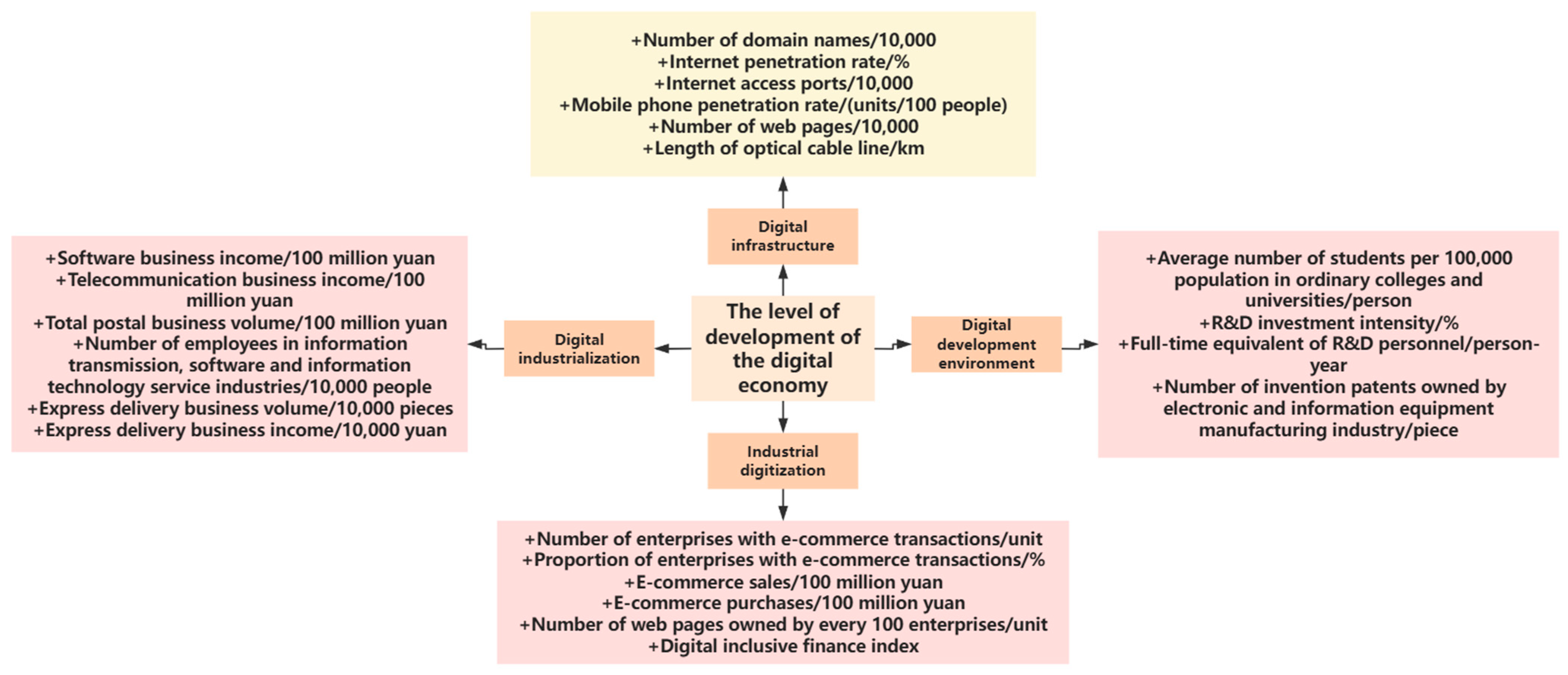

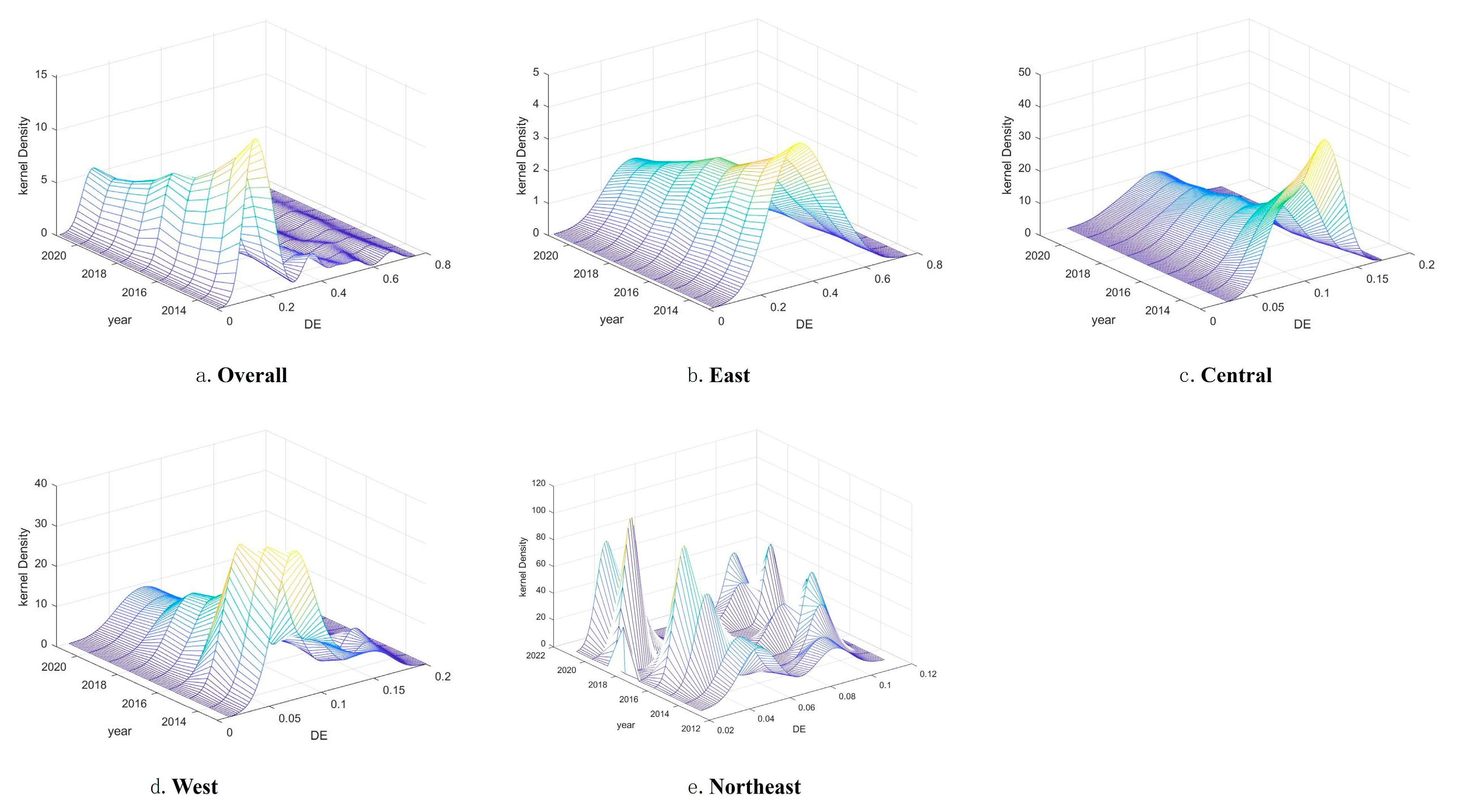
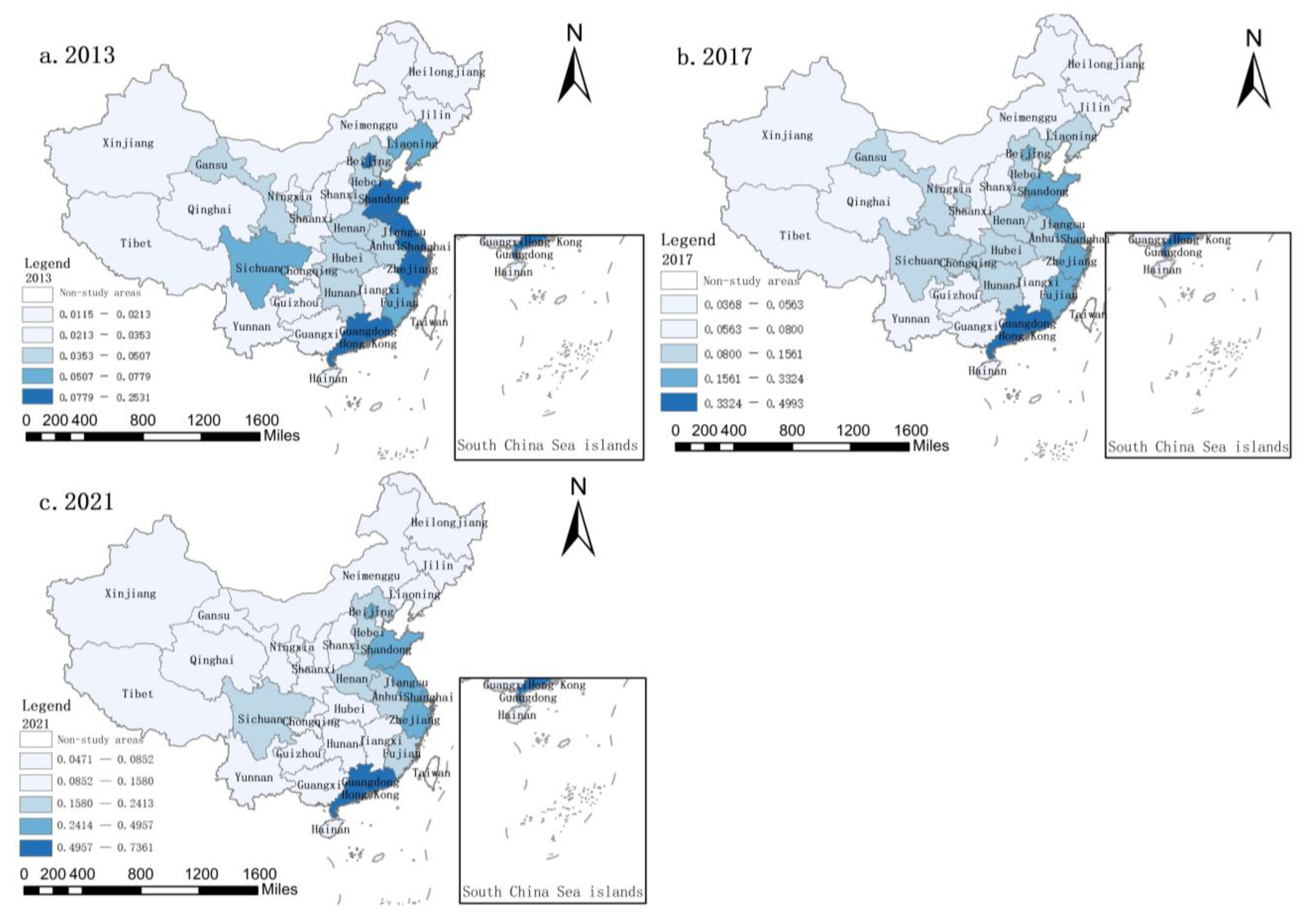
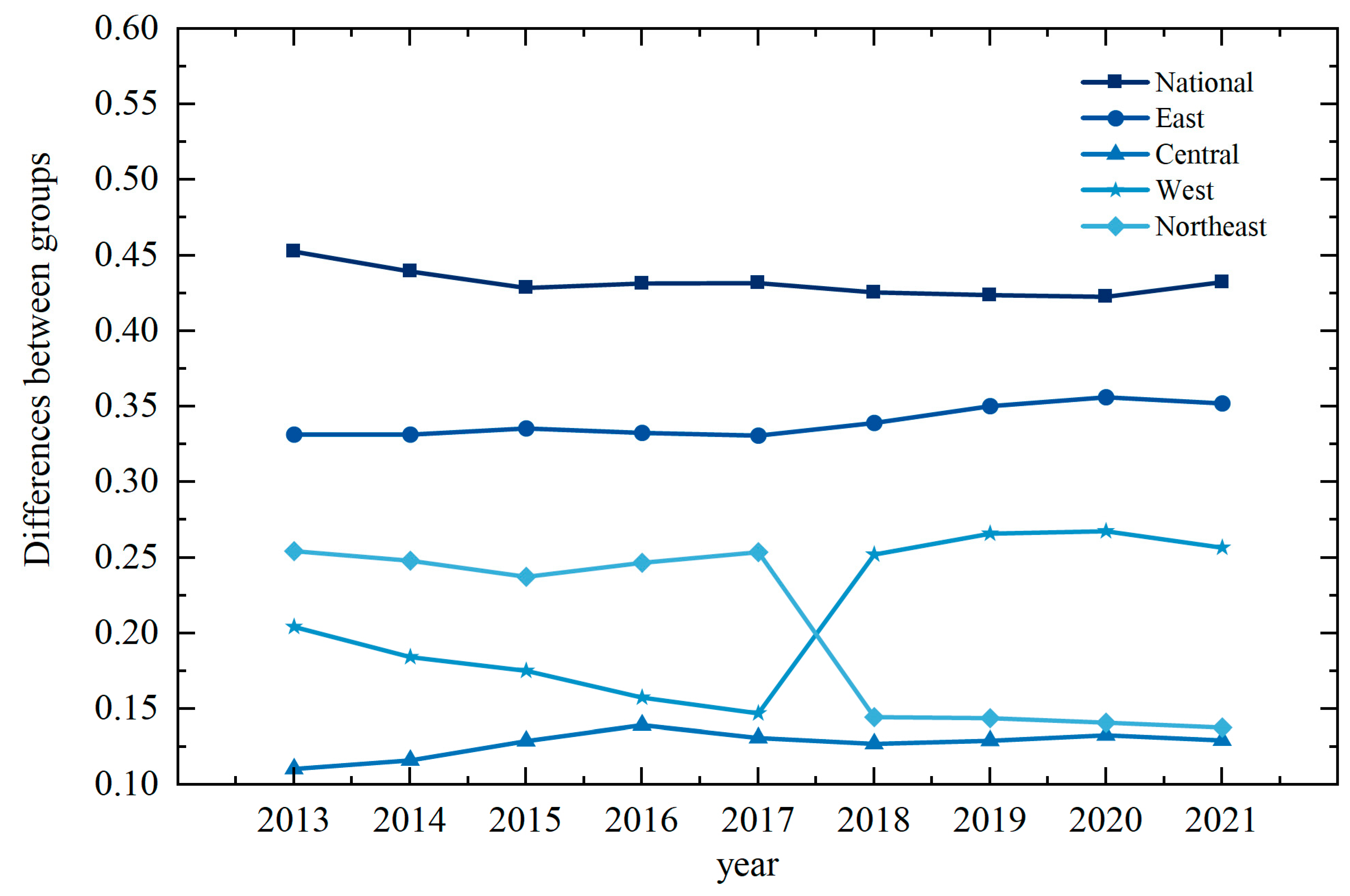
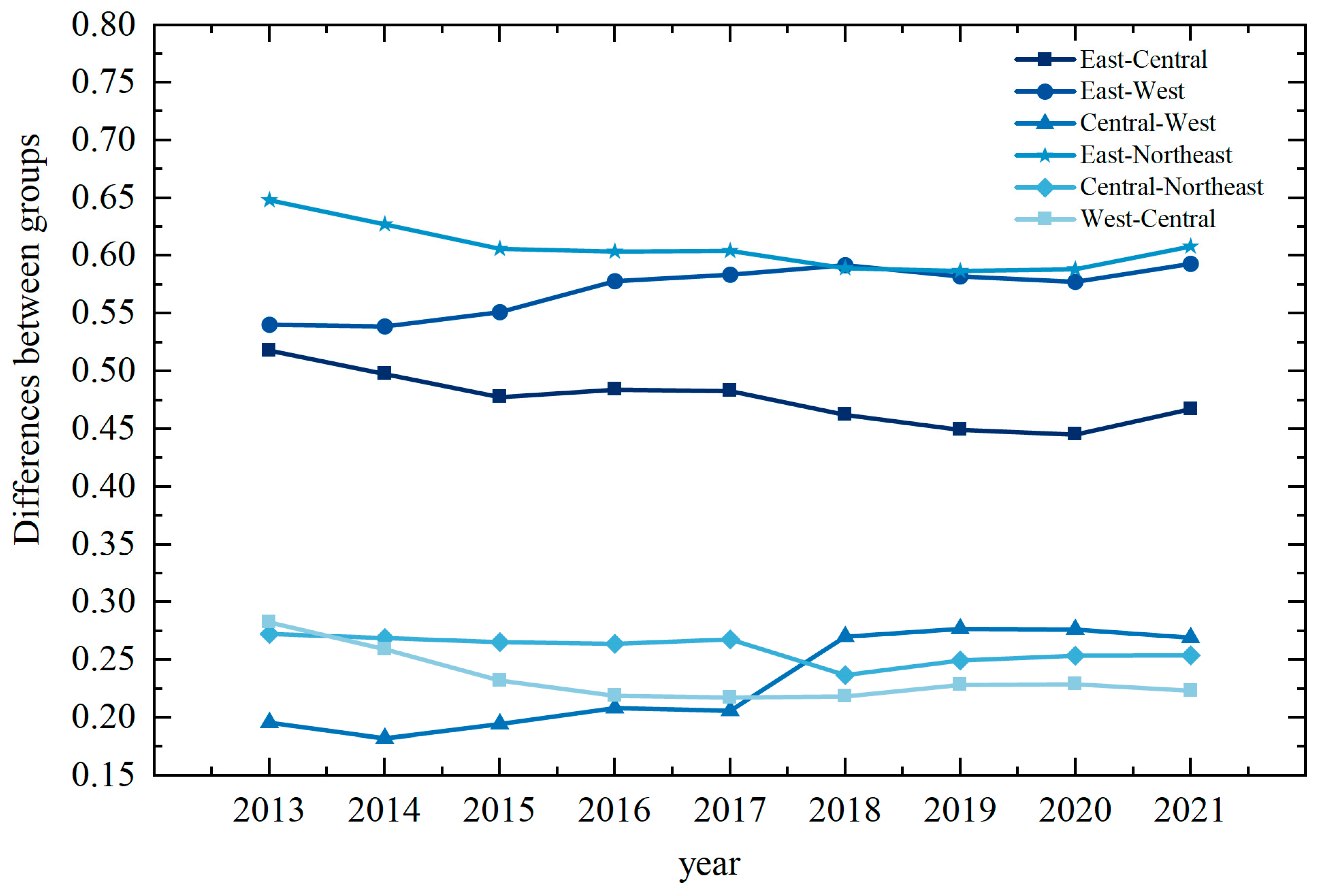
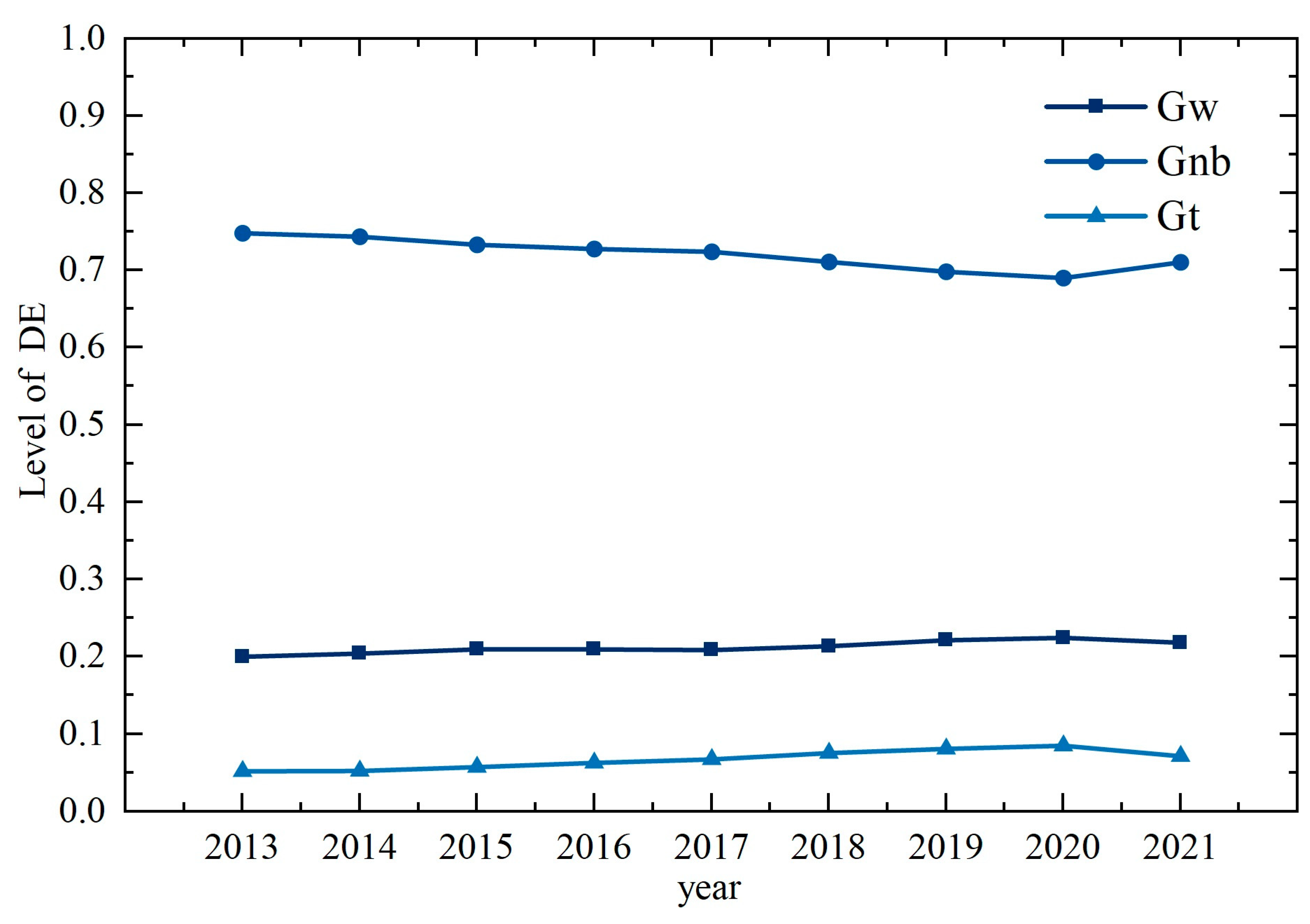

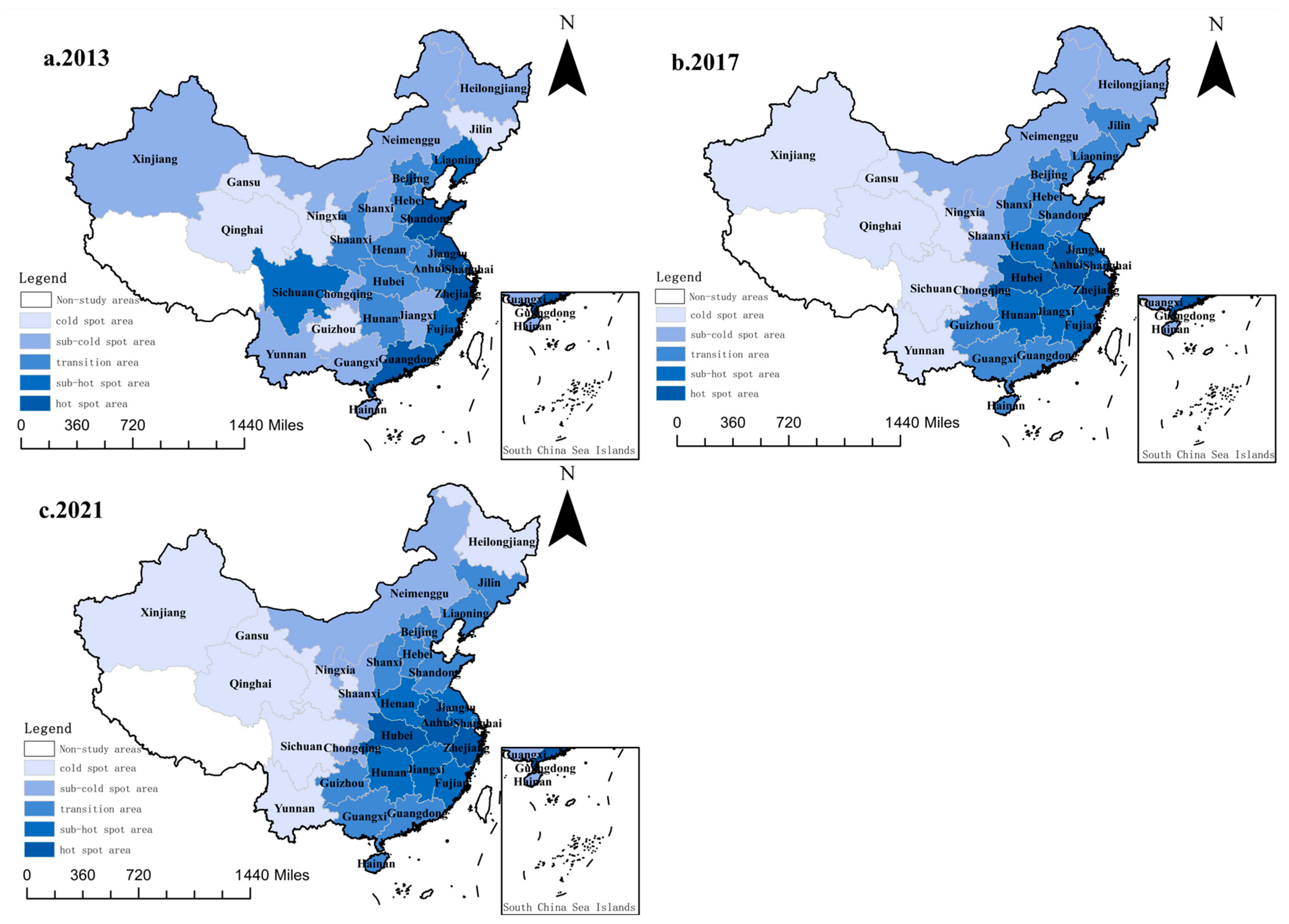
| Province | 2013 | 2014 | 2015 | 2016 | 2017 | 2018 | 2019 | 2020 | 2021 |
|---|---|---|---|---|---|---|---|---|---|
| Anhui | 0.0405 | 0.0560 | 0.0768 | 0.0922 | 0.1091 | 0.1394 | 0.1728 | 0.1949 | 0.1777 |
| Beijing | 0.1599 | 0.2066 | 0.2622 | 0.2974 | 0.3308 | 0.3452 | 0.4057 | 0.4384 | 0.4941 |
| Fujian | 0.0761 | 0.0909 | 0.1190 | 0.1619 | 0.2182 | 0.2262 | 0.2449 | 0.2162 | 0.2129 |
| Gansu | 0.0167 | 0.0251 | 0.0363 | 0.0414 | 0.0491 | 0.0613 | 0.0719 | 0.0817 | 0.0732 |
| Guangdong | 0.2513 | 0.2971 | 0.3616 | 0.4381 | 0.4976 | 0.6113 | 0.7559 | 0.8352 | 0.7339 |
| Guangxi | 0.0248 | 0.0360 | 0.0461 | 0.0578 | 0.0679 | 0.0899 | 0.1228 | 0.1424 | 0.1214 |
| Guizhou | 0.0199 | 0.0284 | 0.0414 | 0.0546 | 0.0631 | 0.0824 | 0.1061 | 0.1185 | 0.1137 |
| Hainan | 0.0258 | 0.0375 | 0.0491 | 0.0524 | 0.0572 | 0.0614 | 0.0697 | 0.0696 | 0.0747 |
| Hebei | 0.0490 | 0.0609 | 0.0744 | 0.0935 | 0.1185 | 0.1413 | 0.1716 | 0.1946 | 0.1669 |
| Henan | 0.0475 | 0.0658 | 0.0896 | 0.1082 | 0.1240 | 0.1639 | 0.1957 | 0.2190 | 0.1830 |
| Heilongjiang | 0.0332 | 0.0410 | 0.0460 | 0.0486 | 0.0602 | 0.0677 | 0.0808 | 0.0924 | 0.0834 |
| Hubei | 0.0412 | 0.0515 | 0.0739 | 0.0834 | 0.0970 | 0.1210 | 0.1525 | 0.1618 | 0.1390 |
| Hunan | 0.0394 | 0.0541 | 0.0673 | 0.0868 | 0.1009 | 0.1303 | 0.1618 | 0.1815 | 0.1556 |
| Jilin | 0.0227 | 0.0318 | 0.0396 | 0.0464 | 0.0549 | 0.0689 | 0.0769 | 0.0858 | 0.0769 |
| Jiangsu | 0.1584 | 0.1875 | 0.2210 | 0.2457 | 0.2819 | 0.3312 | 0.3906 | 0.4297 | 0.3784 |
| Jiangxi | 0.0248 | 0.0341 | 0.0527 | 0.0578 | 0.0780 | 0.1002 | 0.1280 | 0.1449 | 0.1290 |
| Liaoning | 0.0667 | 0.0796 | 0.0953 | 0.0951 | 0.1035 | 0.1228 | 0.1420 | 0.1532 | 0.1378 |
| Inner Mongolia | 0.0261 | 0.0323 | 0.0452 | 0.0533 | 0.0644 | 0.0725 | 0.0889 | 0.1010 | 0.1000 |
| Ningxia | 0.0180 | 0.0259 | 0.0327 | 0.0372 | 0.0412 | 0.0475 | 0.0490 | 0.0523 | 0.0516 |
| Qinghai | 0.0157 | 0.0210 | 0.0317 | 0.0372 | 0.0385 | 0.0444 | 0.0472 | 0.0513 | 0.0558 |
| Shandong | 0.1380 | 0.1432 | 0.1571 | 0.1977 | 0.2315 | 0.2885 | 0.3024 | 0.3307 | 0.3287 |
| Shanxi | 0.0304 | 0.0391 | 0.0493 | 0.0568 | 0.0654 | 0.0905 | 0.0993 | 0.1087 | 0.1000 |
| Shaanxi | 0.0381 | 0.0501 | 0.0650 | 0.0797 | 0.0909 | 0.1128 | 0.1409 | 0.1520 | 0.1407 |
| Shanghai | 0.1233 | 0.1864 | 0.2147 | 0.2621 | 0.2830 | 0.3081 | 0.3561 | 0.4010 | 0.4809 |
| Sichuan | 0.0587 | 0.0810 | 0.1042 | 0.1256 | 0.1535 | 0.1902 | 0.2387 | 0.2710 | 0.2382 |
| Tianjin | 0.0435 | 0.0545 | 0.0712 | 0.0731 | 0.0781 | 0.0890 | 0.1041 | 0.1182 | 0.1180 |
| Xinjiang | 0.0262 | 0.0330 | 0.0427 | 0.0439 | 0.0489 | 0.0661 | 0.0756 | 0.0868 | 0.0787 |
| Yunnan | 0.0261 | 0.0372 | 0.0518 | 0.0584 | 0.0679 | 0.0887 | 0.1154 | 0.1344 | 0.1108 |
| Zhejiang | 0.1276 | 0.1564 | 0.2090 | 0.2533 | 0.2788 | 0.3274 | 0.4018 | 0.4570 | 0.3962 |
| Chongqing | 0.0338 | 0.0493 | 0.0646 | 0.0809 | 0.0917 | 0.1122 | 0.1325 | 0.1488 | 0.1433 |
| Average | 0.0601 | 0.0764 | 0.0964 | 0.1140 | 0.1315 | 0.1567 | 0.1867 | 0.2058 | 0.1931 |
| Years | G | Differences between Groups | Differences within Groups | Contribution Rate | ||||||||||
|---|---|---|---|---|---|---|---|---|---|---|---|---|---|---|
| East–Central | East–West | Central–West | East–Northeast | Central–Northeast | West–Northeast | East | Central | West | Northeast | Gw | Gnb | Gt | ||
| 2013 | 0.453 | 0.518 | 0.541 | 0.196 | 0.649 | 0.272 | 0.272 | 0.332 | 0.111 | 0.204 | 0.254 | 20.00% | 74.82% | 5.08% |
| 2014 | 0.439 | 0.498 | 0.539 | 0.182 | 0.628 | 0.269 | 0.259 | 0.331 | 0.116 | 0.184 | 0.248 | 20.42% | 74.38% | 5.20% |
| 2015 | 0.429 | 0.478 | 0.552 | 0.195 | 0.606 | 0.266 | 0.232 | 0.336 | 0.129 | 0.175 | 0.238 | 20.96% | 73.33% | 5.70% |
| 2016 | 0.432 | 0.484 | 0.578 | 0.208 | 0.604 | 0.264 | 0.219 | 0.333 | 0.139 | 0.158 | 0.247 | 20.94% | 72.79% | 6.27% |
| 2017 | 0.432 | 0.483 | 0.584 | 0.206 | 0.605 | 0.268 | 0.218 | 0.331 | 0.131 | 0.147 | 0.254 | 20.87% | 72.43% | 6.70% |
| 2018 | 0.426 | 0.463 | 0.592 | 0.270 | 0.589 | 0.237 | 0.218 | 0.339 | 0.127 | 0.252 | 0.145 | 21.37% | 71.11% | 7.52% |
| 2019 | 0.424 | 0.450 | 0.582 | 0.277 | 0.587 | 0.250 | 0.229 | 0.350 | 0.129 | 0.266 | 0.144 | 22.12% | 69.82% | 8.06% |
| 2020 | 0.423 | 0.445 | 0.578 | 0.277 | 0.589 | 0.264 | 0.229 | 0.356 | 0.133 | 0.268 | 0.141 | 22.47% | 69.04% | 8.49% |
| 2021 | 0.432 | 0.467 | 0.593 | 0.270 | 0.608 | 0.254 | 0.223 | 0.352 | 0.129 | 0.257 | 0.138 | 21.81% | 71.07% | 7.11% |
| Year | Moran’s I | z | p-Value |
|---|---|---|---|
| 2013 | 0.284 *** | 2.582 | 0.005 |
| 2014 | 0.301 *** | 2.728 | 0.003 |
| 2015 | 0.287 *** | 2.613 | 0.004 |
| 2016 | 0.279 *** | 2.548 | 0.005 |
| 2017 | 0.279 *** | 2.548 | 0.005 |
| 2018 | 0.256 *** | 2.359 | 0.009 |
| 2019 | 0.250 ** | 2.322 | 0.010 |
| 2020 | 0.226 ** | 2.125 | 0.017 |
| 2021 | 0.252 ** | 2.336 | 0.010 |
Disclaimer/Publisher’s Note: The statements, opinions and data contained in all publications are solely those of the individual author(s) and contributor(s) and not of MDPI and/or the editor(s). MDPI and/or the editor(s) disclaim responsibility for any injury to people or property resulting from any ideas, methods, instructions or products referred to in the content. |
© 2024 by the authors. Licensee MDPI, Basel, Switzerland. This article is an open access article distributed under the terms and conditions of the Creative Commons Attribution (CC BY) license (https://creativecommons.org/licenses/by/4.0/).
Share and Cite
Fan, R.; Nie, C.; Zhao, Y.; Hao, C.; Peng, C. Spatiotemporal Distribution and Regional Imbalance of China’s Digital Economy. Sustainability 2024, 16, 6738. https://doi.org/10.3390/su16166738
Fan R, Nie C, Zhao Y, Hao C, Peng C. Spatiotemporal Distribution and Regional Imbalance of China’s Digital Economy. Sustainability. 2024; 16(16):6738. https://doi.org/10.3390/su16166738
Chicago/Turabian StyleFan, Ruina, Chong Nie, Yuanhao Zhao, Chunxu Hao, and Chen Peng. 2024. "Spatiotemporal Distribution and Regional Imbalance of China’s Digital Economy" Sustainability 16, no. 16: 6738. https://doi.org/10.3390/su16166738
APA StyleFan, R., Nie, C., Zhao, Y., Hao, C., & Peng, C. (2024). Spatiotemporal Distribution and Regional Imbalance of China’s Digital Economy. Sustainability, 16(16), 6738. https://doi.org/10.3390/su16166738





